Chapter 3 Conceptual metaphors and metonymies
认知语言学第三章隐喻与转喻
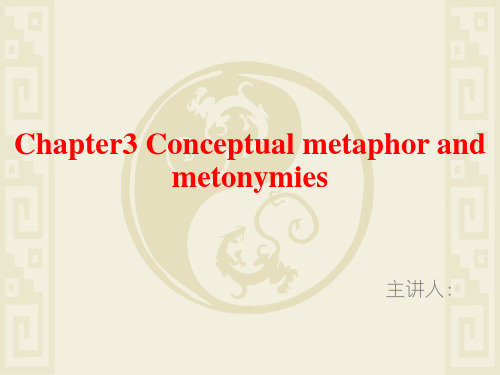
突显原则(principle of prominence)
人们的注意力更容易观察和记忆事物比较突显的方面。
相似原则&顺接原则是隐喻的认知原则。 接近原则&凸显原则是转喻的认知原则。
好的语言是一种圆满的实现,能表达人的感知本 身所不能表现的事情。——查理
语言学上,把由于两个事物的特征上所存在的某 一类似之处,而用指一个事物的词来指代另一个 事物的演变方式叫做隐喻(Metaphor)。
IDEAS (or MEANINGS) ARE OBJECTS LINGUISTIC EXPRESSIONS ARE CONTAINERS COMMUNICATION IS SENDING It’s hard to get that idea across to him. It’s difficult to put my ideas into words. ARGUMENT IS WAR He attacked every week point in my argument.
常规隐喻(conventional or dead metaphors)
“……通过长期建立的常规关系而无意识进入语 言的隐喻才是最重要的。”(Ungerer & Schmid 1996: 117)
莱考夫(1980)把隐喻看做是人们思维、行为和 表达思想的一种系统的方式,即隐喻概念 (metaphorical concept or conceptual metaphor)。
Metonymy has primarily a referential function, that is, it allows us to use one entity to stand for another. […] It also serves the function of providing understanding.
metaphor暗喻的英文例子

Metaphor: Examples of Figurative LanguageIntroductionMetaphor is a type of figurative language that adds depth and creativity to communication. It involves using a word or phrase to describe an object or action, by comparing it to something else unrelated. Metaphors are widely used in literature, poetry, speeches, and everyday conversations to convey abstract ideas and enhance understanding. Inthis article, we will explore various examples of metaphors and their significance.What is a Metaphor?A metaphor is a figure of speech that goes beyond literal meanings to make a comparison between two unrelated things. It establishes a resemblance or association, often based on shared qualities or characteristics. Unlike similes, which use “like” or “as” to make comparisons, metaphors create a direct identification between the subject and object.Examples of Metaphors:1.“Life is a journey.”2.“Time is money.”3.“He is a shining star.”4.“The world is a stage.”5.“Love is a battlefield.”Common Types of MetaphorsMetaphors can be categorized into different types based on their characteristics and usage. Each type offers a unique way to understand and express complex ideas. Let’s explore some common types of metaphors:1. Conceptual MetaphorConceptual metaphors are widely used to understand abstract concepts by relating them to concrete or familiar experiences. They form the basis of our understanding by mapping one domain of knowledge onto another. Some examples include: - “Love is a journey.” - “Ideas are food for thought.” - “Time is a valuable resource.”2. Dead MetaphorDead metaphors are common expressions that were once metaphors but have lost their figurative meaning through repeated use. These metaphors become so ingrained in everyday language that they are now perceived as literal. Examples of dead metaphors include: - “The foot of the mountain” - “The heart of the matter” - “The head of the class”3. Extended MetaphorExtended metaphors are sustained throughout a piece of writing, often through an entire poem or story. These metaphors create a deeper meaning by developin g and expanding the comparison over time. Here’s an example of an extended metaphor from Shakespeare’s play “As You Like It”: “All the world’s a stage, And all the men and women merely players; They have their exits and their entrances…”4. Implied or Implicit MetaphorImplied metaphors do not directly state that one thing is another; instead, they imply the comparison through indirect or figurative language. These metaphors encourage readers to apply their own interpretations and engage with the text more actively. For example: - “She drowned in a sea of grief.” - “The politician danced around the issue.”The Significance of MetaphorsMetaphors play a crucial role in enhancing communication and understanding. They provide a fresh perspective, evoke emotions, and simplify complex ideas. Here’s why metaphors are significant:1. Creativity and ExpressionMetaphors allow individuals to express themselves in unique and imaginative ways. By using metaphors, we can convey our thoughts and feelings more effectively, making the communication process more engaging and memorable.2. Simplification of Complex IdeasMetaphors help simplify complex concepts by relating them to something familiar. They make abstract ideas more tangible and accessible, allowing the audience to grasp difficult concepts easily.3. Arousal of emotionsMetaphors have the power to evoke emotions and create a strong emotional connection with the audience. By using vivid and evocative metaphors, speakers and writers can tap into the audience’s emotions and inspire them.4. Memorable and EngagingMetaphors make the text or speech more captivating and memorable. They add richness and depth to the message, making it more likely to be retained in the audience’s memory.ConclusionMetaphors are powerful tools of expression that add depth, creativity, and clarity to communication. They allow us to think beyond the literal meanings of words and make connections between unrelated ideas. Metaphors enrich our understanding of abstract concepts and evoke emotions, making them an essential part of human communication. So next time you encounter a metaphor, take a moment to appreciate the hidden meaning and the beauty it brings to language.。
Conceptual-metaphors-and-metonymies幻灯片课件

3.1.2 Conventionalized metaphors
head
face eye
mouth lips nose neck shoulder arm
hands
of department, of state, of government, of a page, of a queue, of a flower, of a beer, of stairs, of a bed, of a tape recorder, of a syntactic construction of a mountain, of a building, of a watch of a potato, of a needle, of a hurricane, of a butterfly, in a flower, hooks and eyes of a hole, of a tunnel, of a cave, of a river of a cup, of a jug, of a crater, of a plate of an aircraft, of a tool, of a gun of land, of the woods, of a shirt, bottle-neck of a hill or mountain, of a bottle, of a road, of a jacket of a chair, of the sea, of a tree, of a coat or jacket, of a record player of a watch, of an altimeter/ speedometer
(Conventionalized metaphors of body-parts)
隐喻与转喻
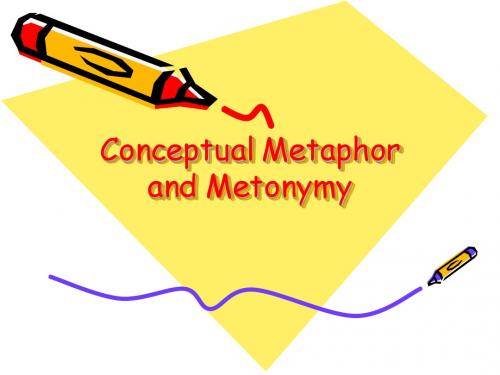
e.g. He is a tiger.
Source domain 源(认知)域
the conceptual domain from which we draw metaphorical expressions to understand another conceptual domain. (tiger)
(7)The PLACE for the EVENT
It is said that the present Iraq would be the second Vietnam. (the Vietnam War in the 1950’s and 1960’s) (8)The CNTROLLED for the CONTROLLER The car stopped in time and avoided a traffic accident. (the car driver, not the car itself) (9)The CONTROLLER for the CNTROLLED
ቤተ መጻሕፍቲ ባይዱ
(4)The MATERIAL for the OBJECT
I have bought some plates and three glasses. (drinking vessels made of glass)
(5)The PRODUCER for PRODUCTION
Tom recently bought a new Ford. (a car produced by Ford company) (6)The PLACE for the INSTITUTION So far, the White House did not say anything about it. (the US presidency or the US government)
Chapter 3 Conceptual metaphors and metonymies12
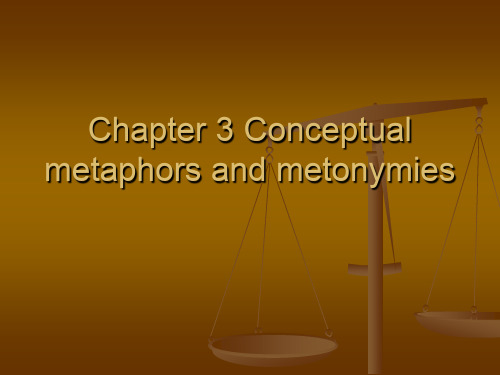
New insights into emotion: five points at P142.
Metaphors as a way of thinking: examples from science and politics
1. Metaphors and the description of linguistic phenomena. Two metaphors: Language form is building block; Language is scaffolding. Langacker criticizes the former and consents the latter. P144-145.
Structural mapping between journey and life.
See figure 3.4.
In the mapping from source domain to target domain, the former is more concrete, while the latter is more abstract.
Similarities and distinctions of metaphor and metonymy
See P128.
Combination of metaphors and metonymies
Combination of metaphors and metonymies is possible. Example and analysis, see P129.
Chapter 3 Conceptual metaphors and metonymies
Defining metaphor
conceptual metaphor
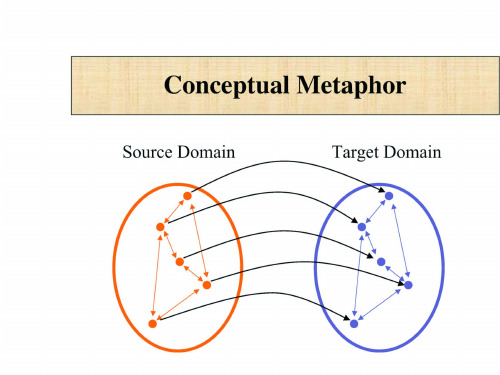
Metaphor & Everyday Language
• CMT motivated by metaphors like TIME IS MONEY • Use of MONEY verbiage to refer to TIME is pervasive and systematic • Metaphor Clusters explained by cross-domain mapping between time and money • Metaphoric language reflects connections between concepts
Contemporary, Expanded View of Metaphor
• Friedrich Nietzsche – metaphor is a process whereby we encounter our world. • Kenneth Burke – metaphor plays an important role in the discovery and description of our world. • Max Black – metaphor is a screen for structuring and organizing our view of the world.
Two classical treatments of metaphor
• as extraordinary language • as decorative
Aristotle
“the application to one thing of the name belonging to another” - Aristotle (metaphor as insightful manner of speech) The most ingenious of Aristotle’s conclusions is that metaphor is above all a tool of cognition. - Umberto Eco, on Aristotle By far the greatest thing is to be a master of metaphor. It is the one thing that cannot be learned from others. It is a sign of genius, for a good metaphor implies intuitive perception of similarity among dissimilars - Aristotle
metaphor and metonymy

A Cognitive Comparison of Metaphor and MetonymyAllan FangContentsu introductionu the nature of metaphor and metonymy u metaphor and metonymy under Grice's theoryu interaction of metaphor and metonymy u conclusionChapter 1: Introduction1.1 Traditional view of metaphor and metonymy•From traditional perspective, metaphor and metonymy have been regarded as figures of speech.•People speak and write metaphorically or metonymically in order to achieve some artistic and rhetorical effects.•In a word, they each belong to a matter of language.1.1.1 traditional view of metaphor•There are three major views of metaphor in terms of traditional linguistic approach: The Comparison view, the Substitution view and the Interaction View.•The Comparison View:dating back to Aristotle.•Aristotle regarded metaphors as implicit comparison between a metaphorical expression and a literal paraphrase based on underlying analogy or similarity. However, he insisted that metaphor should be restricted to poetry only. He gave rise to the distinction between poetic diction and everyday language.1.1.1 traditional view of metaphor•The substitution view holds that a metaphor is where a metaphorical expression is used in place of some equivalent literal expression. For example, "John is a fox." "fox" is substituting for "sly".•The metaphor-as-interaction view derives from LA.Richards. Richards believed "when we use a metaphor, we have two thoughts of different things active together and supported by a single word, or a phrase, whose meaning is a resultant of their interaction".1.1.2 traditional view of metonymy•Aristotle subsumed metonymy and synecdoche under metaphor( Panther&Radden, 1999:1).•The first real definition of metonymy was found in the Rhetorica ad Herennium. In this book, metonymy was seen as a figure of speech which involved change of a word to a closely related or neighbouring one. •Many standard definitions are in accordance with the one given in Webster's New Collegiate Dictionary (1977:724) which describes metonymy as "a figure of speech consisting of the use of the name of one thing for that of another of which it is associated."1.2 cognitive view of metaphor and metonymy •After the publication of Metaphors We Live By in 1980,a cognitive view of metaphor and metonymy wasproposed as the result of the development of cognitive science and linguistics.•In the boo k Metaphors We Live By, Lakoff pointed out metaphor and metonymy have deep connections with the shaping of human cognitive system. "Humanconceptual systems are pervasively structured bymetaphor, metonymy and other kinds of imaginativestructure" (Lakoff and Johnson, 1980:158).1.2.1 cognitive view of metaphor•From the cognitive perspective, metaphor is not only a figure of speech or a rhetoric device or a linguistic phenomenon, but a cognitive process.•Metaphor is the cognitive mechanism whereby one experiential domain is partially "mapped".•That is to say, because of limitation of thinking capacity and lack of ready words or expressions, human beings have to talk of one thing in terms of another, which results in metaphor.• E.g. Her heart swelled with pride.• E.g. His good performance filled him with pride.1.2.1 cognitive view of metaphor•Through metaphor, "We can conceptualize the lessclearly delineated in terms of the more clearlydelineated"(Lakoff& Johnson 1980:59) so that we get an insight into the nature of the concepts that structure oureveryday activities.•Metaphor provides a way of expressing ideas that would be difficult to convey by using literal language.•From above, we can see the focus of metaphor is not inlanguage at all, but in the way we conceptualize one mental domain in terms of another. Linguistic metaphor is theresult of and the tool for human metaphoric cognition.1.2.2 cognitive view of metonymy•The cognitive comprehension of metonymy is different from the traditional views, which has strongly beeninfluenced by centuries of rhetorical and literary studies. •Lakoff and Johnson (1980:39) first described metonymy in cognitive terms as a process which allows us toconceptualize one thing by means of its relation tosomething else.•In a more refined account, Lakoff and Turner(1989)describes metonymy as a conceptual mapping within a single domain which involves a "stand for" relationship and has mainly a referential function.Chapter 2: the nature of metaphor and metonymy2.1 conceptual nature of metaphor and metonymy2.1.1 conceptual metaphor•In recent years, important pioneering works by cognitivelinguists such as Lakoff&Johnson (1980), have demonstrated that metaphor is, in fact, a fundamental property of theeveryday use of language.•Lakoff and Johnson found out there were metaphoricalconcepts lying beneath metaphors used every day, such as "ARGUMENT IS WAR", "TIME IS MONEY", which are components of the whole cognitive system of people in acommunity.2.1.1 conceptual metaphor•Let us take ARGUMENT IS WAR for example: Your claims are indefensible.He attacked every weak point in my argument. His criticisms were right on target.I demolished his argument.I've never won an argument with him.You disagree? Okay, shoot!If you use that strategy, he'll wipe you out.He shot down all of my arguments.2.1.1 conceptual metaphor•From above, we can see the essence of metaphor is understanding and experiencing one kind of thing in terms of another.•Arguments and wars are different kinds of things---verbal discourse and armed conflict---and the actions performed are different kinds of actions. But ARGUMENT is partially structured, understood, performed, and talked about in terms of WAR. The concept is metaphorically structured, the activity is metaphorically structured, and, consequently, the language is metaphorically structured.2.1.2 conceptual metonymy•In cognitive linguistics, metonymy is claimed to be not just a matter of names of things, but essentially a conceptual phenomenon.•Metonymy is a case that we use one entity to refer to another that is related to it.E.g.He likes to read Earnest Hemingway. (= the writings of this author)The Times hasn't arrived at the press conference yet.(= the reporter from the Times)2.1.2 conceptual metonymy•Here is a special case of metonymy, where the part stands for the whole, as in the following:E.g. We need a couple of strong bodies for our team.(= strong people)"There are a lot of good heads in the university.(= intelligent people)We need some new blood in the organization.(= new people)2.2 classification of metaphor and metonymy 2.2.1 classification of metaphor•Lakoff and Johnson have distinguished ontological(本体隐喻), orientational(空间隐喻), and structural metaphors(结构隐喻).•Ontological metaphors, like people are animals, highlight a quintessential feature of the source domain that is then attributed to the target. For example, in the metaphorical utterance Achilles is a lion we take a culturally attributed quintessential feature of lions (their courage)and ascribe this feature to Achilles.2.2.1 classification of metaphor•Orientational metaphors have to do with spatial orientations like up-down, in-out, central-peripheral, etc. and are grounded in our physical and cultural front-back, on-off, experience.•Thus, the fact that humans and many animals sleep lying down and stand up when they awaken provides the experiential grounding for the metaphors CONCIOUS IS UP, UNCONCIOUS IS DOWN .•Structural metaphors refer to metaphors in which one concept is metaphorically structured in terms of another. For example, LIFE IS JOURNEY,TIME IS MONEY.2.2.2 classification of metonymy•According to Panther and Thornburg,there are three groups of metonymy: referential, predicative and illocutionary.•In referential metonymies, a single concept stands for another. For example, "The piano is in bad mood ". In this sentence, "piano" stands for "the piano player".•In predicative metonymies, a statement is used to refer to a different statement. For example, "I'll be brief" stands for "I'll speak briefly”.•In illocutionary metonymies, one illocutionary type stands for another. For example, the assertion“I don't know the bus stop is" stands for the question "where is the bus stop?"Chapter 3: metaphor and metonymy under Grice's theory•3.1 Grice's theory reviewed•Grice holds that communication is more than the encoding and the decoding of linguistic signals. Recognizing thatlanguage is heavily influenced by contextual factors, Grice (1975) proposes his conversational implicature theory. He is the first to systematically study cases in which speakermeaning differs from sentence meaning.•Grice proposes four basic maxims of conversationunderlying the efficient co-operative use of language,which is called the Cooperative Principle.3.1 Grice's theory reviewed•They are(i) the maxim of quality (ii) the maxim of quantity (iii) the maxim of relevance (iv) the maxim of manner.•When a maxim is flouted, Grice shows us that this normally is taken to mean that the speaker might have something more in mind that meets the conversational demand than simply what was said.•Suppose that A and B are talking about a mutual friend C, who is now working in a bank. A asks B how C is getting on in his job, and B replies, "Oh quite well, I think; he likes his colleagues, and he hasn't been to prison yet.”3.1 Grice's theory reviewed•Grice notes that B's answer might be understood to mean something different from, or in addition to, what B actually, literally, said. He believes that this answer might imply that C is the kind of person who could be tempted by the idea of stealing money from the bank, or is prone to get into trouble.•This inference is based on the presupposition that both interlocutors abide by Cooperative Principle. A is asking B about C's level of success with his job, it is expected that B's answer will be related to that topic and based on conventional standards of assessment.•In that case, since the fact of not being in prison is normally not considered to be an acceptable reason for being called successful, this might mean that C is actually not a "normal person" and that his success is relative.3.2 Illustration of metaphor and metonymy under Grice's theory•Grice says that metaphor and metonymy can be partially explained by the Cooperative Principle since metaphor and metonymy are often literally and patently false.•He claims that metaphor and metonymy result from the deliberate violation of the maxim of quality: "Do not say what you believe to be false."• E.g. John is a pig. (metaphor)• E.g. The ham sandwich is waiting for his check. (metonymy)3.2 Illustration of metaphor and metonymy under Grice's theory•Grice's account of metaphor and metonymy may be seen as attempting to offer a more satisfactory explanation developed within a pragmatic framework.•However, it over-simplifies the problem of interpreting metaphor and metonymy, and does not discover the nature of metaphor and metonymy at all.•There is a problem how the hearer derives the implicated proposition by the metonymy and metaphor.•Grice just offers some account of how a metaphoric or metonymic interpretation is triggered but it contributes little to understanding how metaphors and metonymies are interpreted or why they are used.Chapter 4: Interaction of Metaphor and Metonymy•It must be emphasized that the main similarities betweenmetonymy and metaphor investigated by cognitive linguists should not be overlooked.•Both are seen as being conceptual in nature.•Both can be conventionalized.•Both can be used by speakers and understood by hearersautomatically, unconsciously, effortlessly.•Both are means of extending the resources of a language.•Both can be explained mapping processes. However, there are some confusing phenomena in the description of therelationship between metaphor and metonymy.4.1 Conceptual Interaction•According to Barcelona, there are two main subtypes of metaphor-metonymy interaction at this level: The metonymic conceptual motivation of metaphor and the metaphorical conceptual motivation of metonymy.•It has long been noticed that a great many metaphors are motivated conceptually by a metonymy, which is closer to their experiential basis. The metaphor ANGER IS THE HEAT OF A FLUID is conceptually motivated by the metonymy.• E.g. I had reached boiling point.E.g. She got all steamed up.E.g.When I told him, he just exploded.4.2 Contextual Interaction•The second general type of interaction is the purely textual co-instantiation of a metaphor and a metonymy by the same linguistic expression.•See the following sentence:• E.g. The ham sandwich started snarling.•The metaphor in this example is a special version of the people are animals metaphor.The special version is angry behaviour is aggressive animal behaviour.This sentence would refer, in a restaurant situation, to the angry behaviour of the customer who bought the ham sandwich. The metonymy is,consumed goods for customer.4.2 Contextual Interaction•The metaphor and metonymy in the sentence are compatible with each other because both have people as target. But they are conceptually independent from each other.•It is easy to see this fact, as the metonymy can occur without the metaphor.•As for metaphor, it is enough to replace the subject to realize that the metaphor does not depend conceptually on this metonymy for we can say John started snarling.Chapter 5: Conclusion•In cognitive linguistics Although metaphor and metonymyare different cognitive processes, they have much in common.They each have a conceptual basis and function as acognitive process.•Metaphor is the cognitive mechanism whereby oneexperiential domain is partially mapped or projected onto a different experiential domain, so that the second domain ispartially understood in terms of the first one.•Metonymy is a conceptual projection whereby onedomain(the target) is partially understood in terms ofanother experiential domain (the source) included in the same common experiential domain.Chapter 5: Conclusion•In cognitive pragmatics, metaphor and metonymy areseen as results from the deliberate violation of the maxim of quality: "Do not say what you believe to be false." Insuch a framework, metaphor and metonymy involve adeliberate violation of the maxim of truthfulness, because the proposition expressed by the utterance is not identical to the belief of the speaker and the comprehension ofmetaphorical or metonymical utterance depends on thehearer finding the utterance to be false.•All in all, metaphor and metonymy have much incommon although they are different cognitive processes.Thank You!!。
4.隐喻概念(Teacher 用)
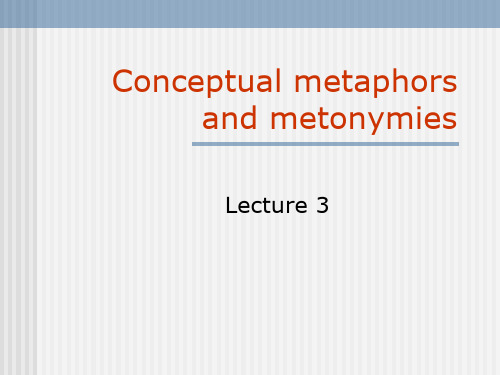
Because of Lakoff‘s aim to uncover deeply embodied conceptual relations in the mind, for him the ideal metaphorical expressions to analyze are not the widely discussed type of examples in (5), but rather those in (6).
什么是隐喻?认知隐喻是研究新隐喻还是 常规隐喻? 如何理解两域之间的映射?它们之间的映 射是对称的吗? 如何理解“隐喻是一种概念现象”?概念 系统的基础是什么? 什么是意象图式? 隐喻的工作机制是什么?
为什么说隐喻不仅是一种语言现象,而且是一种 认知手段? 如何评价下面两句话? “Metaphor is pervasive in everyday life, not just in language but in thought and action‖ (Lakoff & Johnson, 1980) ―The metaphor is not just a matter of language, but of thought and reason.‖ (Lakoff, 1993: 208)
An essential property of a metaphorical expression is deviance. Anomalousness is a necessary feature of a metaphorical expression. If a literal interpretation of an utterance is anomalous, that is normally a signal that we need to apply a different interpretive strategy. (Croft & Cruse, 2004: 206)
- 1、下载文档前请自行甄别文档内容的完整性,平台不提供额外的编辑、内容补充、找答案等附加服务。
- 2、"仅部分预览"的文档,不可在线预览部分如存在完整性等问题,可反馈申请退款(可完整预览的文档不适用该条件!)。
- 3、如文档侵犯您的权益,请联系客服反馈,我们会尽快为您处理(人工客服工作时间:9:00-18:30)。
Tenor and Vehicle
A metaphor consists of two main parts: the tenor and the vehicle. The tenor is the subject to which the metaphor is applied. The vehicle is the metaphorical term through which the tenor is applied. These two parts come together to reach a point of similarity known as a ground. For Example: Life is a yo-yo. It's a series of youps and downs. Here, life is the tenor and yo-yo is the yovehicle. The fact that both life and a yo-yo yohave ups and downs is the ground. ground.
Emotion scenarios can well account for negative emotions such as ANGER, but functions poorly for positive emotions such as JOY and LOVE. See the middle of p142.
Basic emotion words
Two blocks at P137. Basic emotion words serve as reference points to describe nonnonbasic emotion words.
Linguistic reflection of basic vs. nonnon-basic in terms of emotion words
By Richards and Max Black. The essence of metaphor. See the middle lines of P116.
Conventionalized metaphors
Alternative term: dead metaphor, usages that have been demetaphorized. E.g. see Figure 3.2 at P117.
Examples to show the structuring power of metaphors
1. An argument is a journey/battle/container/building. P122ff. 2.The mind/idea is…. P125ff. is…
Experiential view of conceptual metaphors
See P128.
Combination of metaphors and metonymies
Combination of metaphors and metonymies is possible. Example and analysis, see P129.
A general metonymic principle Y Kovecses and Lakoff
2. Metaphors in science: explanatory or constitutive? Mainly explanatory, for examples see computer metaphors. P147. There are also constitutive metaphors according Kuhn(1993). For example, THE ATOM IS A SOLAR SYSTEM, the computer virus metaphor. P148. In popular scientific theories, both types exist. P149.
3.Conceptual metaphors in politics. The explanatory potential of metaphors is often less important than their emotional impact. P149. Metaphors are taken advantage of by politicians and military commanders. P151.
The middle of P126. For our conceptualizing of abstract categories we rely on basic experiences in three ways. P127.
Similarities and distinctions of metaphor and metonymy
A comparison of metonymy and metaphor
The last two paragraphs at P115. Types of contiguity-relations in contiguitymetonymieeory of metaphor
The physiological effects of an emotion stand for the emotion. P131 the middle.
Three features of metonymy as revealed by figure 3.7
For figure see P132. Three features of metonymy: P131-132; P131-
Metonymies of emotion and metaphors of emotion are based on body heat. P133. See Figure 3.8. at P134. Metaphors of emotion abound. But metonymies of emotion are few. In the case of ANGER the contributions of metaphors on the one hand and metonymies on the other are quite balanced. See P134. Lopsided for the case of JOY and LOVE. See P135.
Chapter 3 Conceptual metaphors and metonymies
Defining metaphor
At its most basic, metaphor is a rhetorical trope or a figure of speech, where a comparison is made between two seemingly unrelated objects without using "like" or "as". It is a transference of one object's characteristics onto another. However, it is not to be confused with simile, metonymy, personification and so on so forth.
Structural mapping between journey and life.
See figure 3.4. In the mapping from source domain to target domain, the former is more concrete, while the latter is more abstract. E.g. see Figure 3.5. at P121.
Metaphor is a cognitive instrument, according to Black (1962). Illustration see the middle of P118.
Reddy(1993)’s conduit metaphor and illustrations
Reddy(1993)’ Reddy(1993)’s conduit metaphor: Nine examples are used to illustrate how the imparting of knowledge is conceptualized as how manageable objected are packed, transported, and unpacked. P119.
P138.
Major metonymy and metaphors supporting the category EMOTION, see Figure 3.10. at P140.
Emotion scenario and prototypicality
The bottom of P140 and Figure 3.11 at P141.
Summary of the main points of this chapter. Five points at P152.
New insights into emotion: five points at P142.
Metaphors as a way of thinking: examples from science and politics
1. Metaphors and the description of linguistic phenomena. Two metaphors: Language form is building block; Language is scaffolding. Langacker criticizes the former and consents the latter. P144-145. P144-
